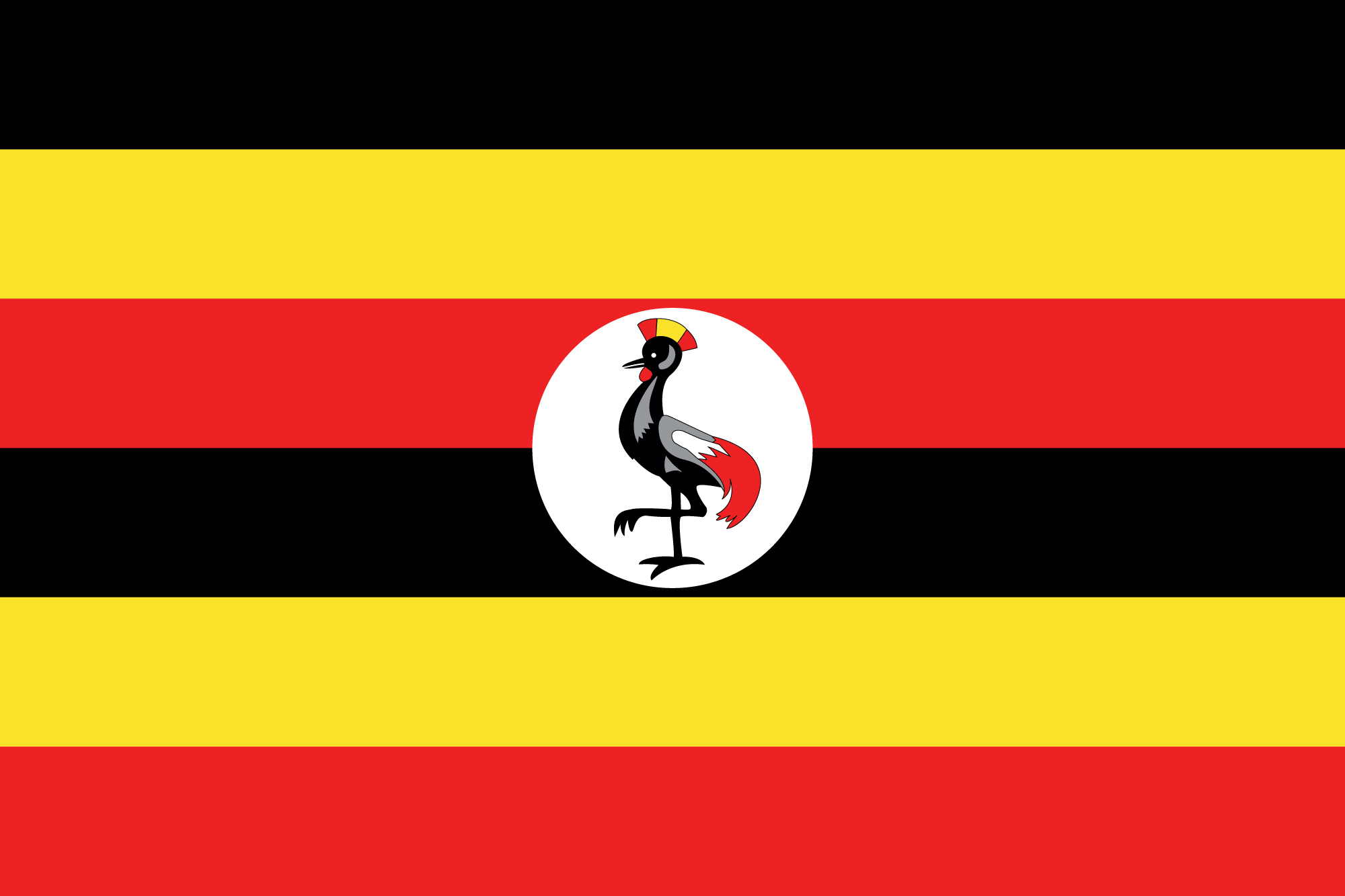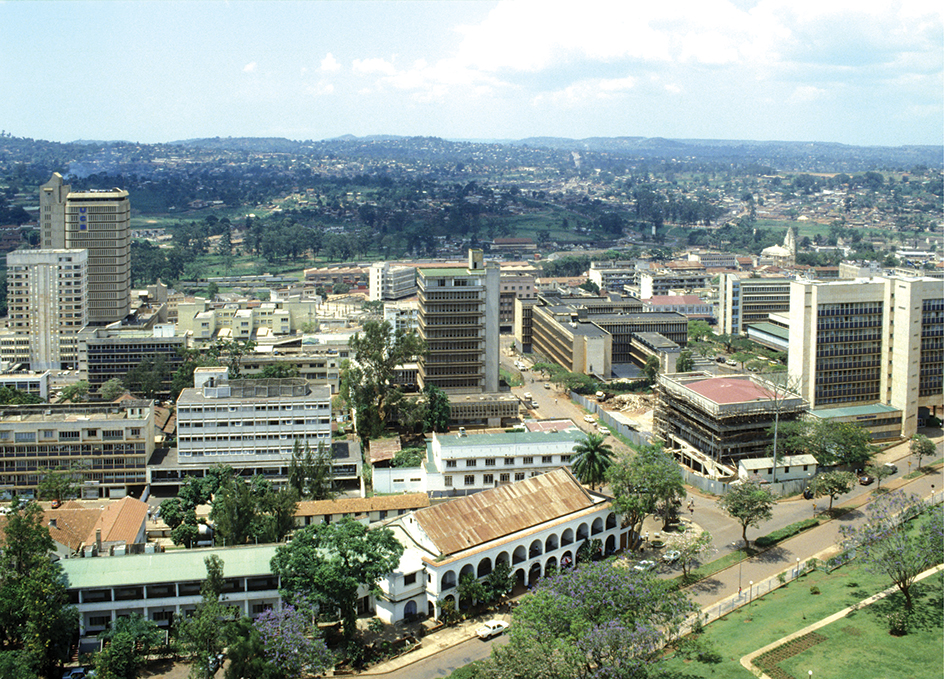Uganda << yoo GAN duh or oo GAHN dah >> is a thickly populated country in east-central Africa. The Africans in Uganda belong to several ethnic groups. English is Uganda’s official language, but the people speak many African languages.

Uganda has magnificent scenery, including snow-capped mountains, thick tropical forests, and semidesert areas. Lakes cover more than a sixth of Uganda. Part of Lake Victoria, the world’s second largest freshwater lake, lies in the country. Many wild animals roam the vast national parks.
For almost 70 years, the United Kingdom governed the territory as the Uganda Protectorate. Uganda won independence in 1962. Kampala is Uganda’s capital and largest city.
Government.
A president, who is elected by the people, heads the government of Uganda. The president appoints a cabinet, which helps carry out the operations of government. A single-house Parliament makes the country’s laws. Both the president and the members of Parliament serve five-year terms.

People.
Ugandans belong to more than 20 ethnic groups, nearly all of which have their own language. Uganda has no language that is understood by everyone. The Ganda, also called the Baganda, are the largest and wealthiest group. They live in central and southern Uganda. Their political and social organization is one of the most highly developed in central Africa. Until 1967, the Ganda had their own kabaka (king) and Lukiko (parliament).
Most Ganda are farmers. Women do much of the farm work. The Ganda live in houses with corrugated iron roofs and walls of cement, cinder block, or mud.
Like the Ganda, three other ethnic groups in southern Uganda had their own kings until 1967. Most of the people are farmers. But the Karamojong in the northeast and several other ethnic groups in the drier parts of the north lead wandering lives as herders. Karamojong men mat their hair with colored clay in elaborate patterns.
About 85 percent of Ugandans are Christians, and about 10 percent are Muslims. Some Ugandans practice traditional African religions. About three-fourths of the people can read and write. Makerere University is in Kampala.
Loading the player...
Uganda's national anthem
Loading the player...
Ugandan folk music
Land.
Most of Uganda is a plateau about 4,000 feet (1,200 meters) above sea level. Thick forests grow in the south. Most of the north is savanna (grassland with low trees), but some northeastern areas of Uganda are semidesert.
Highlands rise near the east and west borders. In the east, Mount Elgon towers 14,178 feet (4,321 meters). Margherita Peak rises 16,762 feet (5,109 meters) in the Ruwenzori Range in the southwest. The Great Rift Valley lies just east of the western highlands and contains Lakes Albert, Edward, and George. The headwaters of the White Nile drain Uganda (see Nile River).
The equator crosses southern Uganda. But because of the high altitude, temperatures are mild. In most areas of the country, the temperature seldom goes above 85 °F (29 °C) at midday, or below 60 °F (16 °C) at night. Most of Uganda receives more than 40 inches (100 centimeters) of rain a year.
Economy.
Over half of Uganda’s workers are farmers, and much of the country’s industry and exports are related to agriculture. The chief food crops include bananas, cassava, corn, and sweet potatoes. Coffee, cotton, sugar cane, tea, and tobacco are raised mostly for export.
Uganda has rich deposits of many minerals, including clay, copper, and gold. In addition to processing agricultural products, Uganda also manufactures cement and other construction materials and textiles. Most of the roads are unpaved. Cargo and passenger ships operate on Lakes Albert, Kyoga, and Victoria, and on the Albert Nile. Entebbe has an international airport.

History.
By A.D. 100, the people in parts of what is now Uganda had developed agriculture and the use of iron. Later, they organized a form of government headed by chiefs. Several local kingdoms developed after 1300. The most important early kingdom was Bunyoro-Kitara.
Arab traders came to the area about 1850. By that time, the Ganda had formed a rich and powerful kingdom, called Buganda. This kingdom had a large army and a highly developed system of government. Explorers and missionaries from the United Kingdom arrived in Uganda during the 1860’s and 1870’s. The United Kingdom made Buganda a British protectorate in 1894. Buganda then helped the United Kingdom conquer nearby territory.
Uganda attained its present boundaries in 1926. Cash crops, such as coffee and cotton, became the basis for its economy. After World War II ended in 1945, Africans played an increasingly important part in governing Uganda. Many Ganda wanted their kingdom to become independent. The movement for independence caused trouble in the 1950’s between the Kabaka of Buganda and the British.
On Oct. 9, 1962, Uganda became independent. Milton Obote, a member of a northern ethnic group, became prime minister. Buganda got special powers and was more independent of the central government than the other kingdoms. In October 1963, Sir Edward Mutesa II, the Kabaka of Buganda, was elected president. But serious differences arose between the Kabaka and Obote. In 1966, Obote dismissed Mutesa and announced a new constitution that made Obote president. Mutesa fled when government troops attacked his palace. Another constitution was adopted in 1967. It made Uganda a republic and abolished the country’s traditional kingdoms, including Buganda.
In 1967, Uganda, Kenya, and Tanzania formed the East African Community to promote trade among the three nations. But strained relations among the three caused the organization to fall apart in 1977.
The Uganda Army overthrew Obote in 1971 and set up a military government. Major General Idi Amin Dada, commander of the country’s armed forces, headed the new government as president.
In 1972, Amin ordered an estimated 40,000 to 50,000 Asians who had been living in Uganda to leave the country. Many Asians had not become Ugandan citizens, but they owned numerous businesses in the country. Amin ruled Uganda as a dictator. Many thousands of Ugandans who disagreed with Amin’s policies were killed, at his order or by his supporters.
In 1978, a border dispute led to fighting between Uganda and Tanzania, which lies to the south. In 1979, Tanzanian troops, aided by Ugandans who opposed Amin, defeated Uganda’s army and overthrew Amin’s government. The Ugandans who opposed Amin took control of the country’s government. In December 1980, elections for a new civilian government were held. Obote, who had been living in exile, returned to Uganda. His political party won the most seats in the National Assembly, and he became president again. Opponents of Obote charged his supporters with election fraud and began a guerrilla war to oust Obote.
In July 1985, military leaders overthrew Obote. They dissolved the National Assembly and took control of the government. General Tito Okello became president. But the National Resistance Movement (NRM), led by Yoweri Museveni, began a military campaign to overthrow Okello. NRM troops captured Kampala in January 1986. Museveni became president. In March, all activities of political parties were suspended. By the end of 1986, Museveni had restored peace to most of Uganda. But fighting between government forces and rebel groups continued in some areas, especially the north. The largest rebel group, the Lord’s Resistance Army (LRA), aims to replace Uganda’s nonreligious government with one based on the Bible’s Ten Commandments. The LRA has carried out thousands of murders, rapes, and child kidnappings.
From 1986 until 1994, a National Resistance Council (NRC) served as Uganda’s legislature. In March 1994, a Constituent Assembly was established to replace the NRC. The assembly approved a new constitution in 1995. Elections for a president and for a Parliament to replace the Constituent Assembly were held in 1996. Museveni was elected president. He was reelected in 2001.
During the 1990’s, a number of cults sprang up in Uganda. In March 2000, hundreds of members of a cult called the Movement for the Restoration of the Ten Commandments of God died in a church fire in southwestern Uganda. The police determined that the fire had been set intentionally. They also discovered hundreds of other bodies of cult members in mass graves. Leaders of the cult reportedly had predicted that the world would end on Jan. 1, 2000. The police suspected that the leaders began murdering members after the prediction did not come true.
In 1999, Uganda, Kenya, and Tanzania signed a treaty to reestablish the East African Community (EAC). The new organization, which aims to promote economic and political cooperation, was formally launched in 2001. In 2007, Burundi and Rwanda joined the EAC.
In a 2005 referendum, Ugandans voted to restore multiparty democracy, which had been suspended in 1986. In February 2006, Yoweri Museveni was reelected president. He was again reelected in 2011 and 2016.
In August 2006, the Ugandan government and the LRA rebel group signed a cease-fire agreement. The two sides were to sign a permanent peace agreement in April 2008, but LRA leader Joseph Kony remained in hiding and did not sign. In December, the LRA launched attacks in the Democratic Republic of the Congo (DRC). In response, Uganda, with the DRC and Sudan, began a campaign to hunt for Kony. Over the next several months, the LRA killed an estimated 900 people in the DRC. The LRA continued to operate in the DRC, as well as in the Central African Republic and South Sudan. In 2017, the Ugandan government ended the hunt for Kony. Although he was not captured, the government claimed the LRA had been effectively neutralized.
Museveni was reelected president for a sixth time in 2021. However, opposition leaders claimed the election was fraudulent.
